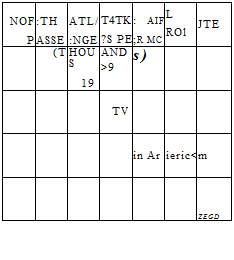Atlantic Number One
![]()
![]()

![]()
![]()
![]()
![]()
![]()
![]()
![]()
![]()

Confident Start
T. W.A. had entered the North Atlantic airways artery in 1946, to face two incumbent airlines from the United States, and, by 1948, seven national airlines from Europe. The United States contingent, comprising Pan American, American Overseas (A. O.A.), and T. W.A., was dominant, carrying about 60% of the total annual passengers, which, by 1950, had exceeded 300,000. In that year, thanks to the popularity of the Constellation, T. W.A. had almost overtaken Juan Trippe’s Pan Am, with 66,000 V. 69.000 passengers. But no sooner had Howard Hughes changed the name to Trans World Airlines, he was confronted with the merger of Pan American and A. O.A., which accounted for 40,000 passengers. This enabled Pan Am to maintain its lead, although T. W.A. was comfortably in second place until 1958.
Obstacles to Progress
When the Jet Age began, however (and as described on page 69) T. W.A. was not prepared for the North Atlantic onslaught. Financial stringency had obliged it to concentrate on the domestic network, while awaiting the long-range Boeing 707s, and a year’s delay cost it dearly. The British B. O.A. C., which had really started the Jet Age, temporarily, with the
Comet in 1952, got into its stride, and pushed T. W.A. into third place for several years. One reason was that both Pan American and B. O.A. C. operated the splendid Boeing 377 Stratocruisers which had great appeal for the trans-ocean air traveller, with its luxury amenities that included a downstairs cocktail bar. And in addition to the Boeing 707, B. O.A. C. had also introduced the Bristol Britannia turboprop ‘Whispering Giant’ to provide added capacity.
T. W.A. Takes the Lead
But during the 1960s, with new ownership and management T. W.A. began to reassert itself. It built up the Boeing 707 fleet energetically, and eventually 133 aircraft—almost as many as Pan Am. By 1969, it had overtaken the hitherto unassailable Pan Am, and continued to maintain at least parity throughout the 1970s. Indeed, many regular trans-Atlantic travellers habitually expressed a preference for the T. W.A. operation and service standards, a reputation that was maintained until in more recent times British Airways gradually claimed ascendancy, and Pan American’s demise was accompanied by T. W.A. owner Carl Icahn’s sale of the coveted London routes in 1991 and 1992.
This chart shows the change of leadership on the North Atlantic
air route during the 1960s.
|
|
||
|
|||
|
|||
|
|||
|
|||
|
|||
|
|||
|
|||
|
|||
|
|||










